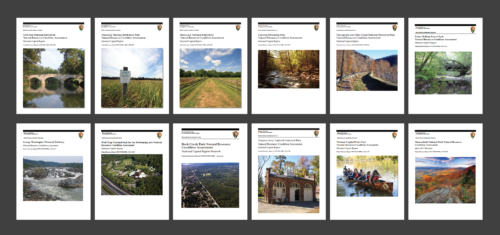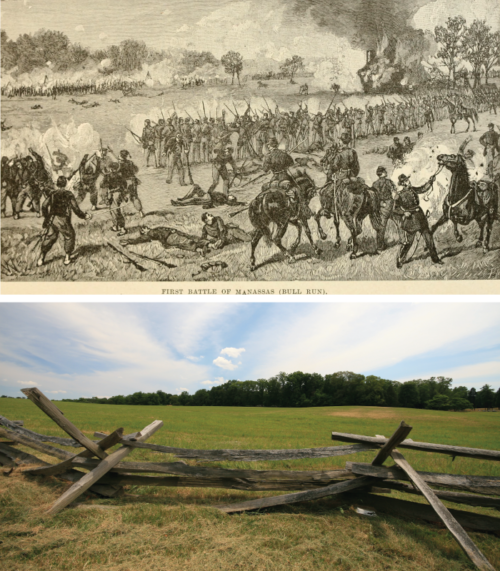Two halves of a whole: the natural and cultural resources of the National Park Service
Emily Nastase ·By: Emily Nastase
The US National Park Service (NPS) is a perfect example of a coupled human and natural system. Realized by Woodrow Wilson in 1916, NPS is housed under the Department of the Interior and cares for the 400+ national parks within America and its territories. NPS, which was originally created to protect the natural spaces within America (beginning with Yellowstone National Park), quickly began to encompass sites of historic, cultural, and recreational value1. The National Park Service makes for an optimal study subject for our class that is studying the interactions between society and the environment.
Katie May Laumann, an IAN Science Integrator, began last week's class with a quick exercise: Write down your definition of "sustainability". Collectively, the class decided that sustainability is "Adaptive management of a resource that maintains, or does not degrade, the condition of that resource for the use of future generations". The NPS mission aligns nicely with how our class has defined "sustainability":
The National Park Service preserves unimpaired the natural and cultural
resources and values of the National Park System for the enjoyment,
education, and inspiration of this and future generations2.
Sustainability, through the natural resource lens, encompasses environmental, social, economic, and institutional elements3. Through a cultural lens, sustainability also includes public policy and technology4. When we think about sustainability in regards to the Park Service, it must include all of these components. A sustainable NPS is one that prevents degradation of the parks and maintains the integrity of the natural and historic spaces for future generations.
Evaluating the sustainability of the park service requires regular condition assessments of NPS natural and cultural resources. One way that the NPS has evaluated their current condition is through Natural Resource Condition Assessments (NRCAs). To familiarize ourselves with the scope of NRCAs, everyone was assigned a park in the National Capital Region to present on during class on Thursday. There are eleven parks in the National Capital Region: Antietam National Battlefield, Manassas National Battlefield Park, Monocacy National Battlefield, Catoctin Mountain Park, Chesapeake and Ohio Canal National Historical Park, Prince William Forest Park, George Washington Memorial Parkway, Wolf Trap National Park for the Performing Arts, Rock Creek Park, Harpers Ferry Historical Park, and National Capital Parks-East.

My assigned park was Manassas National Battlefield Park. This is a park trapped in time. It is managed to maintain its historic integrity as the battlefield during the American Civil War. Two major battles took place here: the First Battle of Bull Run in 1861 and Second Battle of Bull Run in 1862.

Like many of the other National Capital Region parks, Manassas National Battlefield Park has its fair share of ecological problems. Air pollution, high deer density, and exotic invasive plants are just some of the poor-scoring indicators in Manassas. These, combined with some of the better scoring indicators (forest interior species, impervious surface area, forest connectivity, etc.), averaged to a moderate score overall (48%).
Evaluating the natural resource condition of National Capital Region parks through NRCAs is arguably relatively straightforward: ecologically relevant indicators are compared to scientifically-derived thresholds and converted into scores. The habitat-specific, area-weighted average of these scores provides us a big-picture understanding of the natural resource condition. Cultural resources are assessed similarly, though with vastly different datasets. Generally speaking, the Park Service manages their natural and cultural resources independently of one another, but is this approach the best method to ensure sustainability?
IAN has been working with NPS to integrate natural and cultural resource management. The project is called Resource Assessment for Management Strategies, or RAMS for short, and aims to use a common framework to evaluate both natural and cultural resources, as well as identify shared vulnerabilities and management opportunities between the two. A component of the RAMS project is to develop an interactive tool to make these natural and cultural data more accessible. The current prototype of the tool divides park resources into indicator categories (or "buckets" as we have taken to referring to them): Water, biological integrity, landscape dynamics, and air are the natural resources buckets, and built environment, meanings and values, history, and contemporary communities are the cultural buckets.
Our challenge in this class is to develop a research proposal that uses the various approaches to studying environment and society that we have learned about thus far (ecological, anthropological, political, sociological, and economic) to integrate cultural and natural resources for the National Capital Region parks.
With the foundational knowledge of five different disciplines from the first half of the semester, and the specific examples of various tools within these disciplines that we will learn during the weeks remaining, our class is sure to generate some creative solutions for the NPS RAMS project.
References
1. Quick history of the National Park Service. (2018, May 14). Retrieved from https://www.nps.gov/articles/quick-nps-history.htm
2. About Us. Retrieved from https://www.nps.gov/aboutus/index.htm
3. Guide to responsible business management with water policy. Retrieved from https://ceowatermandate.org/policyengagement/understanding-water-policy/
4. The five domains: a paradigm for urban management. Retrieved from http://ecosteptool.org/5domains.html
Next Post > The Nitrogen Cycle is Seizing Up Globally and Scientists Might Not Be Ready to Hear It
Comments
-
Alex Sahi 6 years ago
Learning about the National Park System in the Capital Region made me think about our discussion and reading of William Cronon. It is important to note that parks are made for a specific reason culturally, for example, to preserve a national battlefield. This is a specific heritage preserved for a specific purpose, and that purpose is decided by the ruling class. This can lead to the exclusion of certain groups, and this will be interesting when examining how to bring together cultural and natural resources with this in mind.
-
Jessie Todd 6 years ago
It is not easy to cross the disciplines of social and natural sciences, but with the tools we are learning in class, we are able to combine these different aspects and create solutions. I think learning about NPS's efforts is extremely interesting and I am glad we get to be a part of creating solutions that incorporate both cultural and natural aspects.
-
Tan Zou 6 years ago
Good job, Emily! I appreciate the chance to learn about these interesting national parks with diverse cultural and natural resources, and from the materials prepared for the class, I realized the importance of integrating natural and cultural resource management. These are the research topics I had never thought before until last week. I am also interested in what kind of nature and culture we want to keep in each park as the development of modern society continues. Should they always be the same, or they will change over time? I hope I can answer them after I finish my final assignment.
-
Srishti Vishwakarma 6 years ago
I really liked this line from your blog: "Sustainability, through the natural resource lens, encompasses environmental, social, economic, and institutional elements." You also talked about the cultural perspective in the next sentence. Indeed, NPS is looking our environment through both the lenses. Hence, a great effort put-forth to conserve 400+ national parks in the USA. I wonder how to get people more involved to get aware of the efforts being put by the NPS.
I really liked the connecting ideas in your blog with NPS and sustainability.
Great summary of our past week's class, Emily! -
Matthew Wilfong 6 years ago
It is extremely interesting to be a part of this project with the National Park service. The cultural resource quantification and management couldn't be further from my specialty, so it will be a learning process and hopefully I can apply these techniques to my own research.
Emily, did a very good job at describing the transition of the class towards this new synthesis project. I think she really captured the question and problem we are trying to address and the challenges we will face in doing so.
-
Morgan Ross 6 years ago
This blog post was well articulated. It was very interesting to have Katie May Laumann in class because it was a different perspective than we are used to. The effort of NPS to incorporate cultural and environmental indicators into the parks' assessments will only become more important over time. I hope that upon the completion of the RAMS project, the indicator tool will be available to the public.
-
Alana Todd-Rodriguez 6 years ago
Great job summarizing the class and our upcoming project. I'm so glad to see that the NPS is highlighting the cultural dimensions of the parks. I think it will be a challenge to capture all of the human components, but the tool set we are learning in class will definitely be a good start. Although we all had different parks there were many commonalities that will hopefully shape our final projects into creative, useful proposals for the park services.
-
Brendan Campbell 6 years ago
It is pretty remarkable the amount of data that goes into one of these NRCA's and yet it is so easily readable. Reading these documents and talking about the different national parks was a rewarding experience because it allowed for me to use some of the frameworks we talk about in class and collectively apply them to a real case. Like you said 'a perfect example of a coupled human and natural system.' Well Done!
-
Natalie 6 years ago
Nice blog especially considering the wide range of discussion about National Parks in the Capital region. I would be cautious in public writings like blogs in making statements that could be seen as a false sense of consensus such as "the class decided".
I also thought the concept of witness trees would have been a cool thing to add and play off of that would intrigue the audience.
-
Shannon Hood 6 years ago
Thanks for such a thoughtful recap, Emily! Katie May's in-class discussion and your blog present a really interesting picture of this NPS project and the RAMS tool. Bridging the gap between cultural and natural management will be challenging, but the RAMS tool seems like a very useful strategy for this mission. I'm looking forward to seeing how this tool develops, and to seeing what tools/strategies our groups develop in the coming weeks. Great job!
-
Brian Scott 6 years ago
I knew there were a lot of parks, but over 400 - I didn't know that. There are so many even within our region. My idea of national parks comes from my experience in the desert southwest, where parks like the Grand Canyon are all about nature and scenic views. Here in the DC area, it's more about people and history. This cultural assessment will be fun!
-
Atika 4 months ago
Thank you for sharing this great information with us, i really appreciate your post!